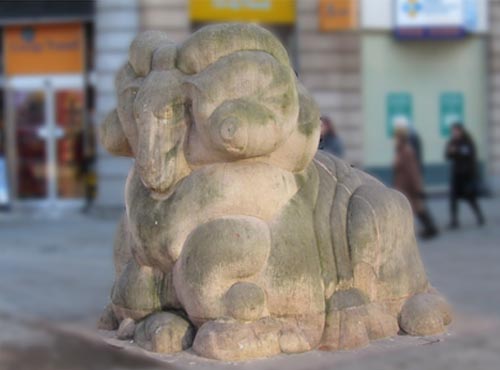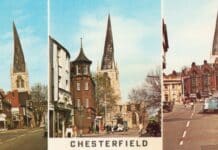Giant Ram of Derby – the city’s mascot – has fascinating and grotesque origins, says ELLIOT DAVIES

The city of Derby has adopted a ram as its mascot.
You’ll find rams everywhere: From Derby FC’s insignia to a line-drawing on all council livery (though I’ve always thought this to look more like a snail). You’ll also find a ram sculpture by Michael Pegler in the city centre.
This can all be traced back to an English folk song which dates back to at least the 17th century. It’s called The Derby Ram, or As I Was Going to Derby.
Like many old English folk songs, it proves that by no means has music only recently been infected by a grim obsession with violence and the macabre.
In no uncertain terms do the lyrics refer to the ram’s immense size and the complications this caused in butchering its carcass:
As I was going to Darby, Sir,
All on a market day,
I met the finest Ram, Sir,
That ever was fed on hay.
This Ram was fat behind, Sir,
This Ram was fat before,
This Ram was 10 yards high, Sir,
Indeed he was no more.
The Wool upon his back, Sir,
Reached up unto the sky,
The Eagles made their nests there, Sir,
For I heard the young ones cry.
A giant ram stalking the landscape apparently accompanied by the cries of eagles?
Why didn’t Ken Russell give this legend the Lair Of The White Worm treatment?
The Wool upon his belly, Sir,
It dragged upon the ground,
It was sold in Darby town, Sir,
For forty thousand pound.
The space between his horns, Sir,
Was as far as a man could reach,
And there they built a pulpit
For the Parson there to preach.
Were a parson to preach from between two gargantuan horns, he’d command the fear and respect of all.
But my oh my, what big teeth he had:
The teeth that were in his mouth, Sir,
Were like a regiment of men;
And the tongue that hung between them, Sir,
Would have dined them twice and again.
This Ram jumped o’er a wall, Sir,
His tail caught on a briar,
It reached from Darby town, Sir,
All into Leicestershire.
And of this tail so long, Sir,
‘Twas 10 miles and an ell,
They made a goodly rope, Sir,
To toll the market bell.
One “ell” is approximately the length of a man’s arm from the elbow to the tip of his middle finger.
Earlier this ram was revealed to be 10 yards tall (“no more”) and yet his tail is apparently over 10 miles long.
With such a serpentine tail, this beast must have been a terrifying sight to behold.
Indeed, his dimensions become more grotesque as the song progresses. Look how disproportionately large his feet are:
This Ram had four legs to walk on, Sir,
This Ram had four legs to stand,
And every leg he had, Sir,
Stood on an acre of land.
Before long, things get really gory:
The Butcher that killed this Ram, Sir,
Was drownded in the blood,
And the boy that held the pail, Sir,
Was carried away in the flood.
Then starts the macabre process of carving up his corpse. Everybody wants a piece of the Derby Ram:
All the maids in Darby, Sir,
Came begging for his horns,
To take them to coopers,
To make them milking gawns.
The little boys of Darby, Sir,
They came to beg his eyes,
To kick about the streets, Sir,
For they were football size.
The tanner that tanned its hide, Sir,
Would never be poor any more,
For when he had tanned and retched it,
It covered all Sinfin Moor.
The Jaws that were in his head, Sir,
They were so fine and thin,
They were sold to a Methodist Parson,
For a pulpit to preach in.
Finally, we get a classic “I guess you had to be there” caveat.
Indeed, Sir, this is true, Sir,
I never was taught to lie,
And had you been to Darby, Sir,
You’d have seen it as well as I.
The beauty of folk music is that it’s rarely canonical. Depending on their mood, anyone can add their own spin to the central conceit and structure of a song.
For that reason, many versions of this song must exist.
I’ve heard of the existence of some versions which detail in similar terms the size of the ram’s testicles and his resulting sexual prowess.
Though I’m yet to find any transcripts of these x-rated versions, it’s this angle which might provide a hint of The Derby Ram’s origins.
Perhaps the legend harks back to a time when maidens everywhere feared the horned gods of fertility prancing through the forests?
The bloodiness of the song and its themes of slaughter may also descend from an ancient practice of sacrificing rams to some kind of hunting deity.
In any case, this beast still casts an enduring shadow over the city of Derby. A monster of that size would never be forgotten so easily.
I wonder which other civic mascots have such equally fascinating and grotesque origin stories?
Listen to the Giant Ram of Derby song!
Elliot Davies has a blog called NinetyEightyTwo, where he “reviews each and any film I see that I haven’t seen before”.







